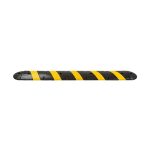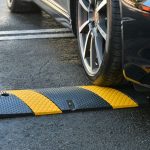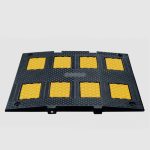[et_pb_section bb_built=”1″ _builder_version=”3.19.18″ custom_margin=”0px||” custom_padding=”0px||”][et_pb_row _builder_version=”3.19.18″ background_size=”initial” background_position=”top_left” background_repeat=”repeat” custom_margin=”0px||” custom_padding=”0px||”][et_pb_column type=”4_4″][et_pb_button _builder_version=”3.19.18″ button_text=”SHOP NOW” button_url=”https://unimat-traffic.com/products/speed-bumps-humps/” button_alignment=”right” background_layout=”dark” box_shadow_style=”preset2″ custom_button=”on” button_bg_color=”#e02b20″ button_icon=”%%114%%” button_icon_color=”#ffffff” button_on_hover=”off” saved_tabs=”all” custom_margin=”-80px|||” /][/et_pb_column][/et_pb_row][et_pb_row _builder_version=”3.19.18″ background_size=”initial” background_position=”top_left” background_repeat=”repeat” custom_margin=”0px||” custom_padding=”0px||”][et_pb_column type=”4_4″][et_pb_text _builder_version=”3.19.18″]
While they’re popular with motorists, the question of whether speed bumps actually work is still a controversial one. In fact, there are several questions that remain unanswered, including how much they reduce traffic volume and what type of impact they have on safety.
This article explores a number of the answers to this question, including some of the key facts about speed bumps.
Furthermore, this article is also a great place to start if you’re considering putting a speed bump in your neighborhood.
[/et_pb_text][/et_pb_column][/et_pb_row][et_pb_row _builder_version=”3.19.18″ background_size=”initial” background_position=”top_left” background_repeat=”repeat” custom_margin=”0px||” custom_padding=”0px||”][et_pb_column type=”1_4″][et_pb_text _builder_version=”3.19.18″ link_option_url=”https://unimat-traffic.com/products/speed-bumps-humps/”]
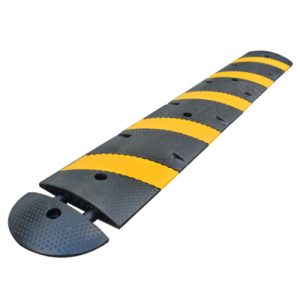
[/et_pb_text][/et_pb_column][et_pb_column type=”1_4″][et_pb_text _builder_version=”3.19.18″ link_option_url=”https://unimat-traffic.com/products/speed-bumps-humps/”]

[/et_pb_text][/et_pb_column][et_pb_column type=”1_4″][et_pb_text _builder_version=”3.19.18″ link_option_url=”https://unimat-traffic.com/products/speed-bumps-humps/”]
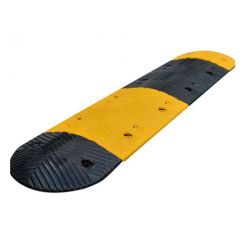
[/et_pb_text][/et_pb_column][et_pb_column type=”1_4″][et_pb_text _builder_version=”3.19.18″ link_option_url=”https://unimat-traffic.com/products/speed-bumps-humps/”]

[/et_pb_text][/et_pb_column][/et_pb_row][et_pb_row _builder_version=”3.19.18″ background_size=”initial” background_position=”top_left” background_repeat=”repeat” custom_margin=”0px||” custom_padding=”0px||”][et_pb_column type=”4_4″][et_pb_text _builder_version=”3.19.18″]
Speed bumps slow down the traffic
Most speed bumps are intended to slow down the traffic, but some have negative side effects. They can cause cars to swerve to avoid them or rev up their engines after hitting them.
Likewise, they can make the roads unsafe by driving thru traffic to alternate routes. Besides slowing traffic, they can also impede emergency vehicles from responding to accidents on time.
Therefore, it’s important to consider the consequences of putting speed bumps in your neighborhood and to find a solution that works for everyone involved.
Another question that needs to be answered is whether speed bumps actually work. Many studies show that they slow traffic.
But there is still no hard evidence that these devices actually slowing down the movement of cars. While they may seem to work, they also may cause damage to vehicles and can put lives in danger.
And in some cases, they may cost as much as $50 to $200 to install or even more at times Not to mention the cost of the product itself.
Safety concerns regarding speed bumps
Although there are a number of reasons why speed bumps can be beneficial, they’re also a major safety concern. Their impact on the environment is also a serious concern.
While some research shows that they reduce speeds by approximately 20 percent or more, the effects of speed bumps depend on the type of vehicle and the conditions of the road.
For example, a speed bumps installation may make nearby residents more annoyed and aggravate people with chronic backaches and spinal cord injuries, or for other various reasons
[/et_pb_text][/et_pb_column][/et_pb_row][et_pb_row][et_pb_column type=”4_4″][et_pb_text _builder_version=”3.19.18″]
| SKU | Description | Length | Height | Width | Weight |
|---|---|---|---|---|---|
| SB206FT | 6 Ft Speed Bump (1) 6′ Section With no End Caps | 72″ | 2″ | 12″ | 48.40 |
| SB207FT | 7 Ft Speed Bump (1) 6′ Section + (2) End Caps | 86″ | 2″ | 12″ | 55.40 |
| SB213FT | Single Lane 12 Ft Speed Bump (2) 6′ Section With no End Caps | 144″ | 2″ | 12″ | 96.80 |
| SB219FT | Double lane 19 Ft Speed Bump (3) 6′ Section + (2) End Caps | 230″ | 2″ | 12″ | 152.20 |
| SB225FT | 25 Ft Speed Bump (4) 6′ Section + (2) End Caps | 302″ | 2″ | 12″ | 200.60 |
| SB2ECAP | End cap | 7′ | 2′ | 12′ | 3.50 |
| SKU | Description | Length | Height | Width | Weight |
|---|---|---|---|---|---|
| SB3039I | 39″ Speed Bump (1) 39″ Section With no End Caps | 39″ | 2″ | 13.7″ | 36.20 |
| SB3117I | 117″ Single Lane Speed Bump (3) 39″ Sections With no End Caps | 117″ | 2″ | 13.7″ | 108.60 |
| SB3137I | 137″ Single Lane Speed Bump (3) 39″ Sections + (2) End Caps | 137″ | 2″ | 13.7″ | 124.20 |
| SB3234I | 234″ Double lane Speed Bump (6) 39″ Sections With no End Caps | 234″ | 2″ | 13.7″ | 217.20 |
| SB3254I-2 | 254″ Double Lane Speed Bump (6) 39″ Sections + (2) End Caps | 254″ | 2″ | 13.7″ | 232.80 |
| SB3ECAP-2 | End cap | 10″ | 2″ | 13.7″ | 7.80 |
| SKU | Description | Length | Height | Width | Weight |
|---|---|---|---|---|---|
| SH1018I | 18.75″ Speed Bump (1) 18.75″ Section with no End Caps | 18.75″ | 1.25″ | 2″ | 22.20 |
| SH1112I | 112.5″ Single Lane Speed Bump (6) 18.75″ Sections with no End Caps | 112.5″ | 1.25″ | 2″ | 133.20 |
| SH1128I | 10 Ft Single Lane Speed Bump (6) 18.75″ Sections + (2) End Caps | 128.5 | 1.25″ | 2″ | 148.80 |
| SH1225I | 225″ Double Lane Speed Bump (12) 18.75″ Sections with no End Caps | 225″ | 1.25″ | 2″ | 266.40 |
| SH1241I | 20 Ft Double Lane Speed Bump (12) 18.75″ Sections + (2) End Caps | 241″ | 1.25″ | 2″ | 282.00 |
| SH1ECAL | LEFT End Cap | 8″ | 1.25″ | 2′ | 7.80 |
| SH1ECAR | RIGHT End Cap | 8″ | 1.25″ | 2′ | 7.80 |
| SKU | Description | Length | Height | Width | Weight |
|---|---|---|---|---|---|
| SH2019I | 19.75″ Speed Bump (1) 19.75″ Section With no End Caps | 19.75″ | 2″ | 3″ | 48.00 |
| SH2121I | 10 Ft Single Lane Speed Bump (5) 19.75″ Sections + (2) End Caps | 121.75″ | 2″ | 3″ | 273.00 |
| SH2240I | 20 Ft Double Lane Speed Bump (11) 19.75″ + (2) End Caps | 240″ | 2″ | 3″ | 561.00 |
| SH2ECAL | LEFT End cap | 11.5″ | 2″ | 3′ | 16.00 |
| SH2ECAR | RIGHT End cap | 11.5″ | 2″ | 3′ | 16.00 |
[/et_pb_text][et_pb_text _builder_version=”3.19.18″]
Consequences to speed bumps
However, speed bumps have many secondary consequences as well. They cause drivers to rev up their engines or swerve around them.
Some of these consequences may even affect the response time of emergency vehicles. The inconvenience of a speed bump can also reduce the value of homes.
Some people believe that these bumps only slow down traffic on the road. But it’s not clear if they’re effective. If they’re effective, they should be widely used to discourage irresponsible drivers.
Speed bumps are an excellent way to slow down traffic and make neighborhoods feel safer. The downsides of speed bumps include increased noise, increased expense, & possible damages.
As long as the bumps are in the right locations, speed bumps are an effective traffic deterrent. In addition, the use of these devices can reduce collisions between pedestrians and cars.
It is important to note that speed bumps only work when people notice them. While this may be the case, many other factors must be considered as well. These include the cost of fuel and repairs.
Final words
In addition to reducing traffic, speed bumps can increase traffic volume and cost. They can damage vehicles and prevent them from responding to emergencies.
They can also increase the cost of goods delivered by trucks. A recent study found that there were no significant differences in real estate values between areas with and without speed bumps.
Nevertheless, there are also benefits to the use of speed bumps in public roads and rural neighborhoods.
[/et_pb_text][/et_pb_column][/et_pb_row][/et_pb_section]


